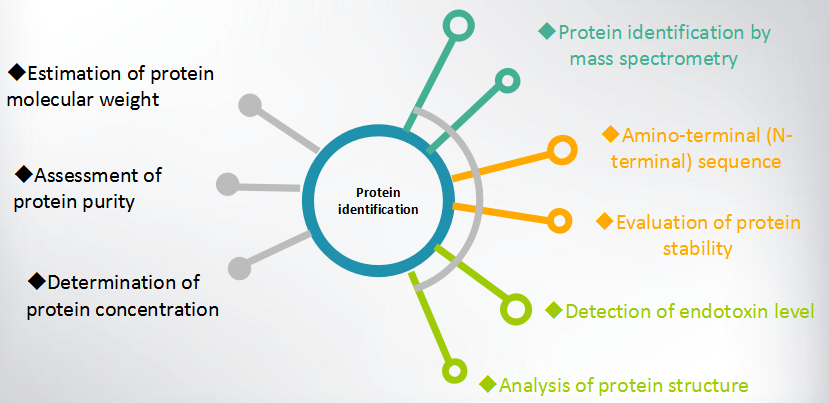Protein Identification and Characterization


- SDS-PAGE (Sodium Dodecyl Sulfate Polyacrylamide Gel Electrophores): the most widely used technique to separate proteins from complicated samples of mixture, used in protein identification including estimations of proteins molecular weight, identification of purificationand assessment of purity.
- Western Blot (also known as immunoblot or protein blot): a widely used analytical technique used to detect specific protein in a complex mixture extracted from cells while giving you information about the size of target protein, dependent on the use of a high-quality antibody directed against the protein.The capability to clearly show the presence of a specific protein both by size and through the binding of an antibody makes it well-suited for evaluating levels of protein expression in cells, and for monitoring fractions during protein purification. Likewise, itis helpful for comparing expression of a target protein from various tissues, or seeing how a particular protein responds to disease or drug treatment.

- SDS-PAGE a commonly used protein identification technique, based on the difference between protein molecular weight to assess protein purity.
- HPLC (High-Performance Liquid Chromatography):a form of column chromatography that pumps a sample mixture or analyte in a solvent (known as the mobile phase) at high pressure through a column with chromatographic packing material (stationary phase). HPLC has the capability to separate, identify, and quantify each components that are present in any sample that can be dissolved in a liquid in trace concentrations as low as parts per trillion. Because of this versatility, HPLC is used in a variety of industrial and scientific applications, such as pharmaceutical industry, environmental monitoring and chemical industry.

- Bradford assay: Bradford assay is a colorimetric assay based on the interaction between Coomassie brilliant blue and arginine and aromatic residues in your protein, resulting in a shift of the absorption maximum of the dye from 465 to 595 nm.In general, the absorbance of a series of known concentrations of a standard protein, generally BSA, is measured to create a standard curve, which can be used to calculate the concentration of your protein sample based on its absorbance.
- BCA assay: BCA, another protein analysis assay, makes use of biuret reaction, in which protein backbone chelates Cu2+ ions and reduces them to Cu1+ ions. The Cu1+ ions then react with bicinchoninic acid (BCA) to form a purple-colored product that absorbs at 562 nm. The procedure is similar to that of the Bradford assay, in which you create a standard curve based on a series of known protein standards.
- ELISA (Enzyme-Linked Immunosorbent Assay): also known as an enzyme immunoassay (EIA), is a common laboratory technique designed for detecting and quantifying an analyte (usually antibodies or antigens). In an ELISA test, an antigen is immobilized to a solid surface and then the antigen combineswith an antibody that is linked to an enzyme. Detection is accomplished by assessing conjugated enzyme activity via incubation with a substrate to produce a measureable product. ELISA is quick and simple to carry out, and since it is designed to rapidly handle a large numbers of samples in parallel, it is a very popular choice for evaluation of various research and diagnostic targets.

Mass spectrometry is an important emerging method for protein identification and characterization. Electrospray ionization (ESI) and matrix-assisted laser desorption/ionization (MALDI) are two primary methods for ionization of whole proteins. In keeping with the performance and mass range of available mass spectrometers, two approaches are used for characterizing proteins including "top-down" strategy and "bottom-up"strategy. In "top-down" strategy of protein analysis, intact proteins are ionized by either of the two techniques described above, and then introduced to a mass analyzer. In "bottom-up" proteomics, identification of the existence of proteins is at the peptide level. A common procedure of "bottom-up" strategy of protein analysis involves using tryptic digestion to obtain masses of individual peptides derived from the protein. Subsequently these peptides are introduced into the mass spectrometer and identified by peptide mass fingerprinting or tandem mass spectrometry.Then the masses are compared against an online database, and probability-based scoring systems are used to determine the closest protein matches.

Amino-terminal (N-terminal) sequence analysis is used to identify the order of amino acids of proteins or peptides, starting at their N-terminal end. The composition of N-terminal sequence has a huge impact on the biological functions and stability of proteins, for example the half-life, subcellular localization, post-translational modification of proteins. Analysis of N-terminal sequence contributes to protein senior structure analysis, further revealing biological function of proteins. BIC provides N-terminal sequence analysis by both Edman degradation and mass spectrometry.

Protein stability evaluation is often considered as an important component of protein production since protein targets can be challenging to work with due to their susceptibility to degradation and aggregation.Protein freezing and thawing assay can be performed to examine proteinstability in the process of transport, storage and applications under the condition of special circumstances.

Endotoxin is a major contaminant found in biologically active substancesaffecting both in vitro and in vivo cell growth and function. Thorough cleanliness in labware, raw materials, and in lab technique is required to substantially reduce endotoxin levels. Besides, BIC protein production team ensures low endotoxin of every outgoing product by doing a final LAL gel clot assay before product deliver.

Circular Dichroism (CD) is based on measuring the differential absorption of left- and right-handed circularly polarised light by optical active compounds at different wave lengths. CD spectroscopy is a sensitive tool to study secondary structure changes and provides the basis for the conformational analysis of macromolecules.The method can be used for the determination of the protein secondary structure (α-helix, β-structure, β-turns) and nucleic acid conformation. Another application of CD spectroscopy is the examination of protein/nucleic acid stability (folding, unfolding and refolding) under the effect of different factors (pH, denaturants, temperature) and the calculation of thermodynamic parameters related to these processes.
Contact Us
* To get a price quotation, please fill the protein service pre-order form and email to Sales@BiologicsCorp.com.
Contact Us


